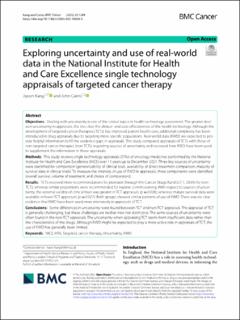| dc.contributor.author | Kang, Ji Yeon | |
| dc.contributor.author | Cairns, John Alexander | |
| dc.date.accessioned | 2022-12-23T09:50:49Z | |
| dc.date.available | 2022-12-23T09:50:49Z | |
| dc.date.created | 2022-12-18T07:16:40Z | |
| dc.date.issued | 2022 | |
| dc.identifier.issn | 1471-2407 | |
| dc.identifier.uri | https://hdl.handle.net/11250/3039352 | |
| dc.description.abstract | Objectives
Dealing with uncertainty is one of the critical topics in health technology assessment. The greater decision uncertainty in appraisals, the less clear the clinical- and cost-effectiveness of the health technology. Although the development of targeted cancer therapies (TCTs) has improved patient health care, additional complexity has been introduced in drug appraisals due to targeting more specific populations. Real-world data (RWD) are expected to provide helpful information to fill the evidence gaps in appraisals. This study compared appraisals of TCTs with those of non-targeted cancer therapies (non-TCTs) regarding sources of uncertainty and reviewed how RWD have been used to supplement the information in these appraisals.
Methods
This study reviews single technology appraisals (STAs) of oncology medicines performed by the National Institute for Health and Care Excellence (NICE) over 11 years up to December 2021. Three key sources of uncertainty were identified for comparison (generalisability of clinical trials, availability of direct treatment comparison, maturity of survival data in clinical trials). To measure the intensity of use of RWD in appraisals, three components were identified (overall survival, volume of treatment, and choice of comparators).
Results
TCTs received more recommendations for provision through the Cancer Drugs Fund (27.7, 23.6% for non-TCT), whereas similar proportions were recommended for routine commissioning. With respect to sources of uncertainty, the external validity of clinical trials was greater in TCT appraisals (p = 0.026), whereas mature survival data were available in fewer TCT appraisals (p = 0.027). Both groups showed similar patterns of use of RWD. There was no clear evidence that RWD have been used more intensively in appraisals of TCT.
Conclusions
Some differences in uncertainty were found between TCT and non-TCT appraisals. The appraisal of TCT is generally challenging, but these challenges are neither new nor distinctive. The same sources of uncertainty were often found in the non-TCT appraisals. The uncertainty when appraising TCT stems from insufficient data rather than the characteristics of the drugs. Although RWD might be expected to play a more active role in appraisals of TCT, the use of RWD has generally been limited. | en_US |
| dc.language.iso | eng | en_US |
| dc.publisher | BMC | en_US |
| dc.rights | Navngivelse 4.0 Internasjonal | * |
| dc.rights.uri | http://creativecommons.org/licenses/by/4.0/deed.no | * |
| dc.title | Exploring uncertainty and use of real-world data in the National Institute for Health and Care Excellence single technology appraisals of targeted cancer therapy | en_US |
| dc.type | Journal article | en_US |
| dc.type | Peer reviewed | en_US |
| dc.description.version | publishedVersion | en_US |
| dc.rights.holder | Copyright 2022 The Author(s) | en_US |
| dc.source.articlenumber | 1268 | en_US |
| cristin.ispublished | true | |
| cristin.fulltext | original | |
| cristin.qualitycode | 1 | |
| dc.identifier.doi | 10.1186/s12885-022-10350-8 | |
| dc.identifier.cristin | 2094751 | |
| dc.source.journal | BMC Cancer | en_US |
| dc.identifier.citation | BMC Cancer. 2022, 22, 1268. | en_US |
| dc.source.volume | 22 | en_US |

